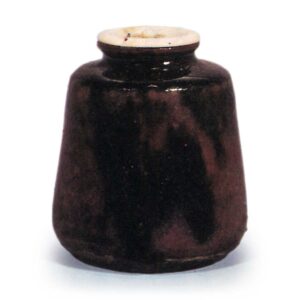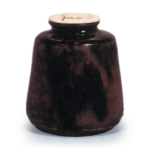
One of the Kinkasan Charyu. This is one of the Kinkasan tea containers, with the inscription “hirozawa” as the main poem. The most famous surviving examples of this hand are Harusame, Kuretake, and Shohin, and those whose extinction is unknown include Akizuki, Akiyoru, Kisaragi, and Fushimi. The clay is red, but it is soft and earthenware-colored, and some of the hard, well-burned clay has a slightly blackish tinge. The thread cutting is thin and slender, and in some cases the thread cutting is not visible. The twists and turns in the mouth construction are beautifully crafted. The underglaze glaze is a dark persimmon color with nashiji, which looks like a mixture of small sand in the glaze, and is called sara glaze, which is the glaze promised by the Hirosawa hand. The upper nadare is black and has a glow like dark black ink. The underglaze glaze is a light persimmon color with a black tinge, and the black overglaze is unevenly applied. This type of tea caddy has a slightly extended mouth, a tapered shoulder, a taut hem, and a tray opening, and as shown in the figure, is very elegant. This form is called hirozawatai, and it is the best of its kind. It is rare to find one without a blemish on the mouth, and as a skilled tool maker would say, this type is not at all difficult to make. One theory is that it was fired by a certain Kuno during the Bunmei period (146987). (Bessho Kibei Ikko Sodensho, Chakki Bengokushu, Manpo-Zensho, Chado Meimono Kou)








